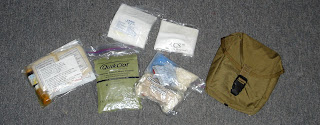I've tried, or at least looked closely at a few of them over the years, and found that none of them are really ideally suited for PPG.
They are best suited for mixing large volumes of oil, but not really great at giving an accurate measure for small amounts like a typical 50-1 mix for a single gallon.
Mixed oil doesn't stay stable all that long, so its really best to mix up just what you think you'll need that day, or for that weekend. Gas doesn't store very well in general, but gas mixed with 2-stroke oil stores particularly poorly.
You can buy a purpose-built syringe called the Hopkins MixMizer that is designed to accurately draw a measure of oil from one container for transfer into a gas can, but this device leaks residue, and doesn't contain product well for transport. Its available here, http://www.thefind.com/garden/info-2-cycle-oil-mix-ratio along with a few other mixing tools including the Accu-Mix bottle, and the Ratio-Rite Flask.
"Quick-2-Mix" that lets you select and measure various different fluid mixtures from 24-1 to 100-1.
Unfortunately, it is large, bulky, and doesn't seal very well. Consequently, it leaks in transport, and gets things messy even if it's only containing residue. As a vessel to transport two-stroke oil for mixing on the road it's hopeless.
Another problem is that it only gives me a choice of a 50-1 level for either five-litres of gas, or for a US gallon. It doesn't tell me the measure for an imperial gallon or four-liters either. My (Canadian) gas cans aren't marked for US gallons, and won't hold five litres. So for me, as a tool for measuring oil mixtures, the Quick-2-Mix is pretty much useless.
Furthermore, the Quick-2-Mix flask is something of a blunt instrument for measuring out small amounts. It's harder to register the lower curve of the meniscus in such a large, wide (2 3/4" diameter) container that can potentially hold almost a litre of oil. A teaspoon (5 mL) plus-or-minus, is hardly noticeable, even if you take a moment and squint at the level marking, but 5 mL more or less, is nevertheless important for doling out the 80 mL required for a 50-1 oil mix for a four-litre final product.
Narrow containers, are far superior for measuring small volumes with exactitude, which is why labs use flasks to get an initial reading of a liquid, and narrow, graduated cylinders to get a final reading of a fiddly amount like 80 mL for a 4-liter dose, or 2.5 ounces for the smaller US gallon.
The most effective solution I've found is in having one or more small containers that contain the exact pre-measured dose of oil that can both store and travel safely.
The most effective solution I've found is in having one or more small containers that contain the exact pre-measured dose of oil that can both store and travel safely.
Just look around and choose, reuse/recycle a container that suits the size of your gas container, according to the ratio of gas to oil that you like.
Most guys I know fly 50-1.
Most guys I know fly 50-1.
For a US gallon, look for a (US ounce) 2.5 ounce bottle. Just make sure it is 2.5 US ounces, and not UK/Imperial ounces.
A US gallon contains 3785.41 mL. Divide that by 50 - equals 75.71 mL (2.56 US ounces)
Try your pharmacist for a freebie, something that will hold your single-shot dose. Liquid medicine bottles often have child-proof lids, so there is less danger of accidental spillage during transport.
This container by Medela for carrying infant formula, http://www.amazon.com/Medela-80-Single-Storage-Bottle/dp/B002QFY4OA seems almost perfectly designed for oil-dosing for PPG.
It has two top-out marks on each side. The 80 mL top-out is perfect for a 50-1 dose for a 4-liter gas can. The other top-out level (a little bit lower) marks 2.5 ounces, which is perfect for one US gallon.
It's made of transparent, unbreakable plastic, has a wide-ish, easy to fill neck, a broad, non-tippy base, and has clear, easy-to-read graduations, (mL/US ounces) and a solid, non-leaking cap.
Best of all, it is a narrow cylinder, so it is easy to fill to a line, and get an accurate read of the small volume of fluid contents within, with only just a glance.
Small plastic bottles abound in practically any size you might ever want. However, the measures that a manufacturer claims, are often not perfect, so it is well to test their claims for accuracy first.
Ounces, like gallons, mean different things in different countries, as do traditional measures like pints, cups, and even teaspoons.
One Teaspoon US is 4.93 mL (usually rounded off to 5 mL without much problem), while one teaspoon UK is 5.92 mL which is closer to 6 mL.
To make matters worse, many conversion sites are inaccurate, giving rounded off, or completely inaccurate numbers. Some internet sites incorrectly assert that an Imperial gallon is equivalent to five litres, when in fact it is much closer to 4 1/2 litres. (4.546 mL in fact.) And some bottles claim 2.5 ounces is equivalent to 80 mL, 90 mL, and 100 mL depending on who's ounces are being measured, and how well.
It's nuts, but at least a millilitre (or a CC) is a millilitre everywhere, and as much as someone may dislike the metric system, at least it's consistent.
Here's a handy and reliable conversion table on a page that will also allow you to convert specific amounts. http://convert.french-property.co.uk/
Here is another exacting converter










 OTHER STUFF: Sprains are commonplace in PPG, so I keep a MINIMUM of three instant Cold Packs nearby.
OTHER STUFF: Sprains are commonplace in PPG, so I keep a MINIMUM of three instant Cold Packs nearby.